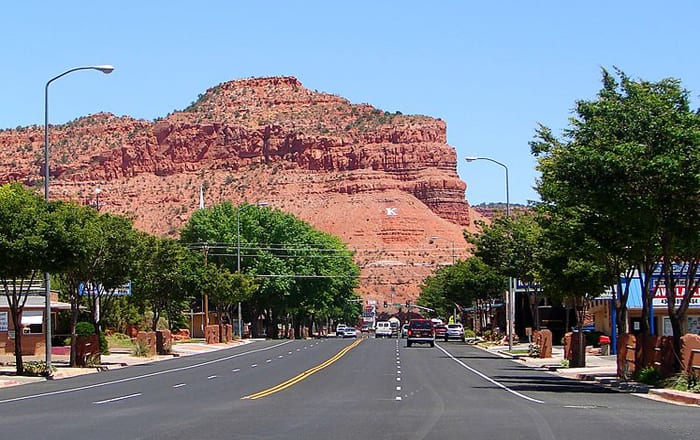
Written by Jeff Frey with Southern Utah News
The Coral Cliffs Golf Course again dominated the Kanab City Council’s agenda on July 14, with over 100 concerned citizens present at the Kanab Library meeting.
Mayor Robert Houston prefaced the discussion by saying, “I don’t want to dwell on what has transpired in the past regarding the golf course, but want to focus on what can be done now with it.”
Houston stated he has tried to work with Mike Schollian, who has previously said he represents both himself and his partners as owners of the course, but has had very little success doing so in the past eight months. Schollian was not in attendance secondary to some medical issues, according to Houston.
“I see the golf course as an asset to the community worth keeping, although it is not presently an economic driver,” said Houston. “We laid out a course of action to Mr. Scholian two weeks ago that we thought would keep the course viable, but he came back with demands that are unacceptable to the city.”
Houston provided income versus expense statements from seven golf courses in relatively similar sized communities in southern Utah. Four showed losses of between $30,000-$60,000 per year, Richfield broke even, and Price and Moab made $49,000 and $90,000 respectively.
The Kanab course reportedly took in $63,000, with $122,000 in expenses. In the previous meeting, Schollian said he could not afford to make up that difference with his own money and therefore wants to close the golf course. The course has not had any maintenance to speak of so far this year and is not in playable condition at this time.
Houston estimated it would cost the city $110,000 a year to maintain and operate the course, generating about $65,000 in revenue after raising the 18-hole rate from $15 to $20. Several people in the room felt that revenues could be substantially higher than that estimate if the course was properly maintained, managed and promoted.
Council member Kirt Carpenter stated, “The cost to the city does not include the water at $70,000/year, electricity to pump the water at $27,000/year and dedicating one well to do so with a replacement cost of $250,000.”
However, the city afforded Schollian’s group water for the first ten years as part of the deal made when the city sold it.
Councilmember Joe B. Wright sees it as a benefit to the community but fears the city could be in the same predicament Schollian is facing after a couple years.
Most comments from those in attendance focused on ways to keep the course open through volunteerism at the clubhouse and maintenance operations. Pro-shop employees were budgeted at a $40,000 expense.
Considerable effort and perhaps a conservatively estimated $10,000 in cost to get the course back into playable condition would be necessary. After that is achieved, many felt aggressively promoting the golf course via campaigns by the Travel Council, Kanab City website, local realtors, Best Friends and state advertisements that have been brandishing what southern Utah has to offer could markedly increase play and revenue. It is also known that many regular local golfers have quit playing the course because of issues related to maintenance and management.
Lynette Foster related that two individuals, having 390 shares of water between them, have offered to donate those shares to the course to help defray water costs.
Statements from those in a position to know reported potential transplants to Kanab, as well as many tourists, ask if Kanab has a golf course and make their plans accordingly.
Although most present felt the city should make efforts to sustain the golf course, some others felt it was bailing out a failed business, or at best, trying to support a declining pastime.
However, the question of where we are as a community and what do we have to offer our residents, visitors and potential newcomers appeared to supersede doubts about keeping the course open.
Mayor Houston reminded everyone that the city does not own the course. Unless Schollian and his partners (who remain unknown and perhaps should be identified and contacted, as some suggested) are agreeable to the terms and conditions set forth by the city, there is no way the city can intervene to keep the course operational.
In addition to discussion of the Coral Cliffs Golf Course, Matt Brown outlined tentative plans for the refurbishing and additions to the old Kanab Middle School located in the heart of downtown Kanab. The Kane County School District has been negotiating the transfer of ownership to Kane County and Kanab City of the 13-acre parcel for over two years.
Plans include space for Kanab City offices, a senior center, conference center, outdoor recreation and festival area, art gallery, gymnasium remodel and 400-seat outdoor amphitheater, which would replace the existing Terrace venue. The Heritage Museum would also undergo remodeling at an estimated cost of $500,000.
The Utah State Community Impact Board would be solicited for $10 million in the form of 60 percent in grant money and 40 percent in a low-interest loan. The loan would be paid back utilizing that portion of transient room tax money received locally from the state.
Several residents living on or near Navajo Dr. in the Kanab Creek Ranchos voiced complaints about water run-off flooding their street and running through their home sites, causing considerable damage. This has been an ongoing problem only exacerbated by recent heavy rains. The mayor said the heavy rains “are unusual” but promised to look into the situation.
Jeff Mosdell and Vicki Brackney were appointed to the Kanab Library Board.
Original article appeared at Southern Utah News.




